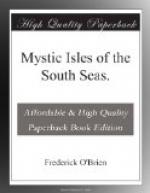In the club, after all had been made secure, the skippers and managers of trading houses gathered to discuss the weather. Tahiti is not so subject to disastrous storms as are the Paumotu Islands and the waters toward China and Japan, yet every decade or two a tidal-wave sweeps the lowlands and does great injury. Though this occurs but seldom, when the barometer falls low, the hearts of the owners of property and of the people who have experienced a disaster of this kind sink. The tides in this group of islands are different from anywhere else in the world I know of in that they ebb and flow with unchanging regularity, never varying in time from one year’s end to another.
Full tide comes at noon and midnight, and ebb at six in the morning and six in the evening, and the sun rises and sets between half past five and half past six o’clock. There is hardly any twilight, because of the earth’s fast rotation in the tropics. This is a fixity, observed by whites for more than a century, and told the first seamen here by the natives as a condition existing always. Another oddity of the tides is that they are almost inappreciable, the difference between high and low tide hardly ever exceeding two feet. But every six months or so a roaring tide rolls in from far at sea, and, sweeping with violence over the reef, breaks on the beach. Now was due such a wave, and its possibilities of height and destruction caused lively argument between the traders and the old salts. More than a dozen retired seamen, mostly Frenchmen, found their Snug Harbor in the Cercle Bougainville, where liberty, equality, and fraternity had their home, and where Joseph bounded when orders for the figurative splicing of the main-brace came from the tables.
George Goeltz, a sea-rover, who had cast his anchor in the club after fifty years of equatorial voyaging, was, on account of his seniority, knowledge of wind and reef, and, most of all, his never-failing bonhommie, keeper of barometer, thermometer, telescopes, charts, and records. When I had my jorum of the eminent physician’s Samoan prescription before me, I barkened to the wisdom of the mariners.
Captain. William Pincher, who had at my first meeting informed me he was known as Lying Bill, explained to me that some ignorant landsmen stated that this tidal regularity was caused by the steady drift of the tradewinds at certain hours of the day.
“That don’t go,” said he, “for the tides are the same whether there’s a gale o’ wind or a calm. I’ve seen the tide ’ighest ’ere in Papeete when there wasn’t wind to fill a jib, and right ’ere on the leeward side of the bloody island, sheltered from the breeze. How about it at night, too, when the trade quits? The bleedin’ tide rises and falls just the same at just the same time. Those trades don’t even push the tidal waves because they always come from the west’ard, and the trades are from the east.”
“I can look out of the veranda of this Cercle Bougainville and tell you what time it is to a quarter of an hour any day in the year just by looking at the shore or the reef and seein’ where the water is,” said Goeltz. “You can’t do that any place on the globe except in this group.”




